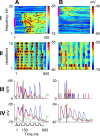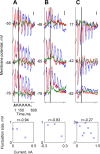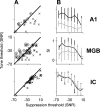Representation of tone in fluctuating maskers in the ascending auditory system
- PMID: 15703404
- PMCID: PMC6725998
- DOI: 10.1523/JNEUROSCI.4007-04.2005
Representation of tone in fluctuating maskers in the ascending auditory system
Abstract
Humans and animals detect low-level tones masked by slowly fluctuating noise very efficiently. A possible neuronal correlate of this phenomenon is the ability of low-level tones to suppress neuronal locking to the envelope of the fluctuating noise ("locking suppression"). Using in vivo intracellular and extracellular recordings in cats, we studied neuronal responses to combinations of fluctuating noise and tones in three successive auditory stations: inferior colliculus (IC), medial geniculate body (MGB), and primary auditory cortex (A1). We found that although the most sensitive responses in the IC were approximately isomorphic to the physical structure of the sounds, with only a small perturbation in the responses to the fluctuating noise after the addition of low-level tones, some neurons in the MGB and all A1 neurons displayed striking suppressive effects. These neurons were hypersensitive, showing suppression already with tone levels lower than the threshold of the neurons in silence. The hypersensitive locking suppression in A1 and MGB had a special timing structure, starting >75 ms after tone onset. Our findings show a qualitative change in the representation of tone in fluctuating noise along the IC-MGB-A1 axis, suggesting the gradual segregation of signal from noise and the representation of the signal as a separate perceptual object in A1.
Figures











Similar articles
-
Emergence of Spatial Stream Segregation in the Ascending Auditory Pathway.J Neurosci. 2015 Dec 9;35(49):16199-212. doi: 10.1523/JNEUROSCI.3116-15.2015. J Neurosci. 2015. PMID: 26658870 Free PMC article.
-
Detection of Tones Masked by Fluctuating Noise in Rat Auditory Cortex.Cereb Cortex. 2017 Nov 1;27(11):5130-5143. doi: 10.1093/cercor/bhw295. Cereb Cortex. 2017. PMID: 28334090
-
Phase-locked responses to pure tones in the inferior colliculus.J Neurophysiol. 2006 Mar;95(3):1926-35. doi: 10.1152/jn.00497.2005. Epub 2005 Dec 7. J Neurophysiol. 2006. PMID: 16339005
-
Coding of communication calls in the subcortical and cortical structures of the auditory system.Physiol Res. 2008;57 Suppl 3:S149-S159. doi: 10.33549/physiolres.931608. Epub 2008 May 13. Physiol Res. 2008. PMID: 18481905 Review.
-
Cortical representations of pitch in monkeys and humans.Curr Opin Neurobiol. 2006 Aug;16(4):391-9. doi: 10.1016/j.conb.2006.07.001. Epub 2006 Jul 13. Curr Opin Neurobiol. 2006. PMID: 16842992 Free PMC article. Review.
Cited by
-
Comodulation masking release in the inferior colliculus by combined signal enhancement and masker reduction.J Neurophysiol. 2017 Feb;117(2):853-867. doi: 10.1152/jn.00191.2016. Epub 2016 Oct 26. J Neurophysiol. 2017. PMID: 27784801 Free PMC article.
-
Comodulation Enhances Signal Detection via Priming of Auditory Cortical Circuits.J Neurosci. 2016 Dec 7;36(49):12299-12311. doi: 10.1523/JNEUROSCI.0656-16.2016. J Neurosci. 2016. PMID: 27927950 Free PMC article.
-
Responses of auditory cortex to complex stimuli: functional organization revealed using intrinsic optical signals.J Neurophysiol. 2008 Apr;99(4):1928-41. doi: 10.1152/jn.00469.2007. Epub 2008 Feb 13. J Neurophysiol. 2008. PMID: 18272880 Free PMC article.
-
Stimulus-specific adaptation in a recurrent network model of primary auditory cortex.PLoS Comput Biol. 2017 Mar 13;13(3):e1005437. doi: 10.1371/journal.pcbi.1005437. eCollection 2017 Mar. PLoS Comput Biol. 2017. PMID: 28288158 Free PMC article.
-
Low-level information and high-level perception: the case of speech in noise.PLoS Biol. 2008 May 20;6(5):e126. doi: 10.1371/journal.pbio.0060126. PLoS Biol. 2008. PMID: 18494561 Free PMC article.
References
-
- Bajo VM, Rouiller EM, Welker E, Clarke S, Villa AE, de Ribaupierre Y, de Ribaupierre F (1995) Morphology and spatial distribution of corticothalamic terminals originating from the cat auditory cortex. Hear Res 83: 161-174. - PubMed
-
- Borg-Graham LJ, Monier C, Fregnac Y (1998) Visual input evokes transient and strong shunting inhibition in visual cortical neurons. Nature 393: 369-373. - PubMed
-
- Bringuier V, Chavane F, Glaeser L, Fregnac Y (1999) Horizontal propagation of visual activity in the synaptic integration field of area 17 neurons. Science 283: 695-699. - PubMed
Publication types
MeSH terms
LinkOut - more resources
Full Text Sources
Miscellaneous
